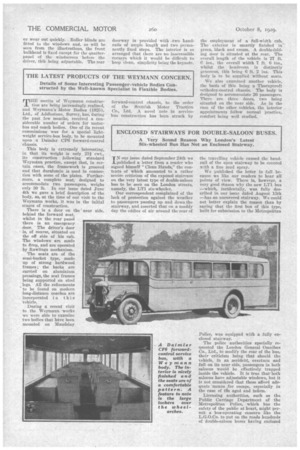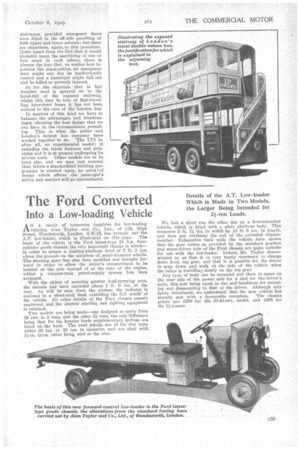ENCLOSED STAIRWAYS FOR DOUBLE-SALOON BUSES.
Page 76

Page 77

If you've noticed an error in this article please click here to report it so we can fix it.
A Very Sound Reason Why London's Latest Six-wheeled Bus Has Not an Enclosed Stairway.
IN our issue dated September 24th we published a letter from a reader who signed himself " Clean Hands," the contents of which amounted to a rather severe criticism of the exposed staircase on the very latest type of double-saloon bus to be seen on the London streets, namely, the LT1 six-wheeler.
Our correspondent complained of the lack of protection against the weather to passengers passing up and down the stairway, and asserted that on a muddy day the eddies of air around the rear of the travelling vehicle caused the handrail of the open stairway to be covered with a tine mud spray.
We published the letter in full .because we like our readers to hear all points of view. There is, however, a very good reason why the new LT1 bus —which, incidentally, was fully described in our issue dated August 13th —has an uncovered stairway. We could not better explain the reason than by saying that the first bus of this type, built for submission to the Metropolitan Police, was equipped with a fully enclosed stairway.
The police authorities specially requested the London General Omnibus Co., Ltd., to modify the rear of the bus, their criticism being that should the vehicle, in an accident, overturn and fall on its near side, passengers in both saloons would be effectively trapped inside the vehicle. It is true that-both saloons have adjustable windows, but it is not considered that these afford adequate means for escape, especially in the case of die aged and infirm.
Licensing authorities, such as the Public Carriage Department of the Metropolitan Police, which has the safety of the public at heart, might permit a bus-operating concern like the L.G.O.Co. to put on the roads hundreds of double-saloon buses having enclosed stairways, provided emergency doors were fitted in the off-side panelling of both upper and lower saloons ; but there are objections, again, to this procedure. Quite apart from the fact that it would probably mean the sacrificing of one or two seats in each saloon, there is always the fear that, no matter how ingenious the construction, an emergency door might one day be inadvertently opened and a passenger might fall out and be killed or severely injured.
As for the objection that in bad weather mud is sprayed on to the hand-rail of the exposed stairway, whilst this may be true of fast-travelHug inter-town buses it has not been noticed in the case of the London bus.
In matters of this kind we have to balance; the advantages and disadvantages, choosing the best design that we can have in the 'circumstances prevailing. This, is what the police and London's largest bus company have worked together to do. The LT1 is, after all, an experimental model; it embodies the latest features and principles and it is at present undergoing its service tests. Other models are to be tried also, and we may rest assured that, before a standardized building programme is entered upon, no point of design which affects the passenger's safety and comfort will go unconsidered.




























































































































